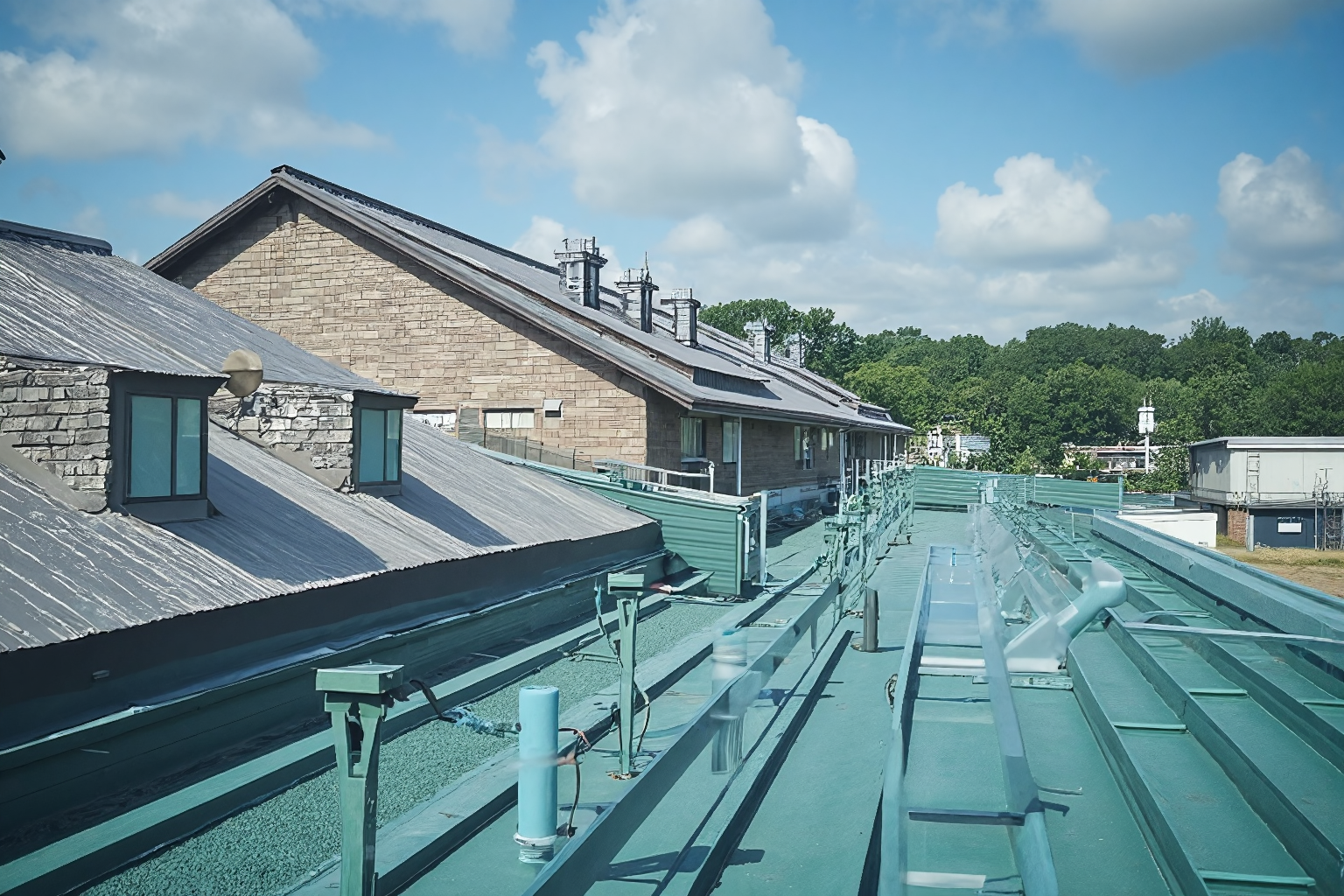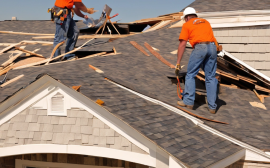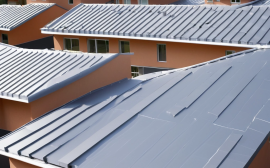The Future of Roofing: Advanced Coatings Take Center Stage
The roof, a building’s primary defense against the elements, is undergoing a significant technological transformation, driven by the need for greater energy efficiency, extended lifespan, and reduced environmental impact. Traditional roofing materials like asphalt shingles and single-ply membranes, while still prevalent, are increasingly making way for advanced coating technologies that offer superior performance and sustainability. These coatings represent a paradigm shift in roofing, providing building owners, contractors, architects, and maintenance professionals with innovative solutions for both new construction and retrofitting projects.
This article explores the latest innovations in roofing coating technologies, providing valuable insights for stakeholders across the building lifecycle. From cool roofs designed to mitigate urban heat island effect to durable silicone and polyurethane systems engineered for long-term weather resistance, the evolution of roofing coatings is reshaping the industry landscape. Understanding the diverse range of available options, their benefits, and best practices for installation is crucial for making informed decisions that align with modern building performance standards.
The increasing focus on green building practices and sustainable architecture further underscores the importance of these advanced roofing solutions. For instance, cool roof technology, by reflecting solar radiation and reducing heat absorption, directly contributes to lower energy consumption and a smaller carbon footprint. This aligns perfectly with the growing demand for energy-efficient buildings and helps achieve sustainability goals. Moreover, the enhanced durability and reduced maintenance requirements of advanced coatings like silicone and polyurethane minimize lifecycle costs and contribute to long-term building resilience.
In the realm of construction technology, the seamless integration of these coatings with existing and emerging building systems is simplifying installation processes and enhancing overall building performance. From a building maintenance perspective, the extended lifespan and reduced need for repairs translate to significant cost savings and improved operational efficiency. Furthermore, the development of smart roofing systems, incorporating sensors and monitoring technology, is paving the way for predictive maintenance and real-time performance optimization. This convergence of technology and sustainability is revolutionizing the roofing industry, offering a new era of high-performance, environmentally responsible roofing solutions. As the construction industry continues to evolve, exploring and adopting these innovations will be essential for creating durable, sustainable, and cost-effective buildings for the future.
Exploring Emerging Roofing Coating Technologies
Emerging roofing coating technologies are rapidly transforming the construction and building maintenance landscape, offering solutions that extend beyond simple weather protection. The key players in this revolution include cool roofs, silicone, acrylic, and polyurethane coatings, each with distinct properties catering to specific needs and priorities in roofing. These advancements directly address the growing demand for sustainable roofing solutions and contribute to green building initiatives by improving energy efficiency and reducing the environmental impact of structures.
The selection of the appropriate roof coating hinges on a comprehensive understanding of these technologies and their respective applications. Cool roof technology utilizes specialized pigments that dramatically increase solar reflectance and thermal emittance, effectively minimizing heat absorption. This reduction in heat gain translates directly into lower cooling costs for buildings, particularly in warmer climates. Studies have shown that cool roofs can decrease a building’s energy consumption by up to 15%, making them a powerful tool for architects and building owners seeking to achieve LEED certification or comply with stringent energy efficiency standards.
For example, implementing cool roof technology on a large commercial building in Phoenix, Arizona, resulted in a significant reduction in peak cooling demand and annual energy expenditure. This exemplifies the potential of cool roofs to contribute to both economic and environmental sustainability. Silicone coatings stand out for their exceptional durability and resistance to the elements. Their inherent UV resistance prevents degradation from prolonged sun exposure, while their superior waterproofing capabilities safeguard against leaks and water damage, crucial for effective roof maintenance.
Silicone’s flexibility allows it to expand and contract with temperature fluctuations, preventing cracking and maintaining a tight seal over time. This makes silicone roofing a preferred choice for buildings in regions with extreme weather conditions. Furthermore, silicone coatings are often chosen for re-roofing projects as they can be applied over existing roofing materials, minimizing waste and installation costs, aligning with sustainable construction practices. Acrylic coatings present a cost-effective alternative for a wide range of roofing substrates, offering a balance of performance and affordability.
These coatings provide good reflectivity and waterproofing, making them suitable for various commercial and residential applications. Acrylic coatings are relatively easy to apply and maintain, reducing labor costs and extending the lifespan of the underlying roof. While they may not possess the same level of durability as silicone or polyurethane, advancements in acrylic polymer technology have significantly improved their resistance to weathering and UV degradation. Their versatility and affordability make them a popular choice for building owners seeking to enhance roof performance without incurring significant capital expenditure.
Polyurethane coatings are renowned for their high tensile strength and exceptional resistance to chemicals and abrasion, making them ideal for roofing systems subjected to heavy foot traffic or exposure to harsh industrial environments. These coatings form a seamless, durable membrane that protects against punctures, tears, and chemical spills. Polyurethane roofing is frequently used in manufacturing facilities, warehouses, and other industrial buildings where roof integrity is paramount. Moreover, polyurethane’s ability to create a closed-cell foam insulation system further enhances its energy efficiency, contributing to reduced heating and cooling costs. The robustness and long-term performance of polyurethane coatings make them a valuable investment for building owners seeking a durable and sustainable roofing solution. The future of roofing will likely see further innovations in polyurethane technology, including bio-based formulations and enhanced UV resistance.
Benefits of Advanced Roofing Coatings
Advanced roofing coating technologies offer a multifaceted array of benefits, revolutionizing building performance and sustainability across various sectors. From enhanced energy efficiency and extended roof lifespan to reduced maintenance costs and improved environmental impact, these innovations are transforming the roofing industry. Cool roof technology, for instance, utilizes specialized pigments to reflect solar radiation and reduce heat absorption, leading to significantly lower cooling loads, particularly in warmer climates. This translates directly to reduced energy consumption and lower utility bills, a crucial factor for building owners and facility managers.
Studies by the Lawrence Berkeley National Laboratory have shown that cool roofs can decrease peak rooftop temperatures by 20-60°F, resulting in substantial energy savings. Furthermore, the extended lifespan offered by advanced coatings like silicone and polyurethane minimizes the need for frequent roof replacements, reducing long-term costs and minimizing disruptions to building operations. These durable coatings provide robust protection against weather damage, UV degradation, and even chemical exposure, ensuring long-term performance and minimizing the need for costly repairs.
This durability directly contributes to reduced maintenance costs, freeing up resources for other building maintenance priorities. The sustainability benefits of advanced roofing coatings are equally compelling. By reducing energy consumption, these technologies contribute to lower greenhouse gas emissions, aligning with green building principles and supporting broader sustainability initiatives. Cool roofs, in particular, mitigate the urban heat island effect, a phenomenon where urban areas experience significantly higher temperatures than surrounding rural areas. This effect not only increases energy demand but also contributes to air pollution and heat-related health issues.
The extended lifespan of these coatings also minimizes waste generation associated with frequent roof replacements, further reducing environmental impact. Furthermore, some advanced coatings are formulated with sustainable materials and manufacturing processes, minimizing their overall environmental footprint. For example, certain silicone and acrylic coatings are now available with low-VOC (volatile organic compound) content, improving indoor air quality and reducing harmful emissions. From a construction technology perspective, the application of advanced roofing coatings is often simpler and less disruptive than traditional roofing methods.
Spray-applied coatings, for example, can conform to complex roof geometries, ensuring seamless coverage and minimizing the risk of leaks. This ease of application can also translate to faster installation times and reduced labor costs. Moreover, these coatings can be applied over existing roofing systems, avoiding the need for costly and time-consuming tear-offs, which also reduces construction waste sent to landfills. This aligns with sustainable construction practices and minimizes disruption to building occupants. The integration of smart technologies, such as sensors and monitoring systems, is further enhancing the capabilities of advanced roofing coatings.
These systems can provide real-time data on roof performance, enabling proactive maintenance and optimizing energy efficiency. For building maintenance professionals, the durability and longevity of advanced roofing coatings translate to reduced workload and lower maintenance costs. The resistance to weathering, UV degradation, and other environmental factors minimizes the need for frequent inspections, repairs, and replacements. This allows maintenance teams to focus on other critical building systems and preventative maintenance tasks, improving overall building performance and extending the useful life of the entire structure. The seamless, monolithic nature of many advanced coatings also reduces the potential for leaks and other common roofing problems, minimizing the need for reactive maintenance and costly emergency repairs. In conclusion, advanced roofing coating technologies represent a significant step forward in sustainable building practices. By enhancing energy efficiency, extending roof lifespan, reducing maintenance burdens, and minimizing environmental impact, these innovations are transforming the roofing industry and contributing to a more sustainable built environment.
Real-World Applications and Case Studies
Cool roof technology has moved beyond theoretical benefits, demonstrating tangible energy savings across diverse applications. In Los Angeles, for example, a study of retrofitted commercial buildings showed an average reduction of 10-15% in cooling energy consumption after the application of reflective roof coatings. Schools in Phoenix, Arizona, have also embraced cool roofs, reporting not only lower energy bills but also improved indoor comfort levels for students and staff, a crucial factor in educational environments. Residential complexes, particularly in sun-belt states, are increasingly adopting cool roofing as a standard feature, enhancing property values and reducing the strain on local power grids during peak summer months.
These real-world implementations highlight the effectiveness of cool roofs as a cornerstone of sustainable building practices. Silicone roofing solutions have emerged as a reliable choice for protecting industrial facilities and warehouses, where harsh environmental conditions and demanding operational requirements necessitate robust roofing systems. The chemical resistance of silicone coatings makes them particularly well-suited for environments where exposure to pollutants or industrial byproducts is a concern. In coastal regions, silicone’s exceptional resistance to salt spray and UV degradation extends the lifespan of roofing systems, minimizing the need for frequent repairs or replacements.
Furthermore, the seamless nature of silicone roofing eliminates common leak points, providing enhanced protection against water damage and preserving the integrity of valuable inventory and equipment stored within these facilities. This makes silicone a key component in proactive roof maintenance strategies. Polyurethane roofing systems are frequently selected for applications demanding high resistance to both chemical exposure and heavy foot traffic. Manufacturing plants, food processing facilities, and aviation hangars often utilize polyurethane coatings to withstand the rigors of their respective operations.
The durability and flexibility of polyurethane allow it to accommodate the expansion and contraction of roofing substrates, preventing cracks and maintaining a watertight seal. Moreover, polyurethane’s ability to be formulated with varying degrees of hardness and slip resistance makes it adaptable to specific application requirements, such as walkways or equipment platforms on rooftops. This versatility solidifies polyurethane’s position as a leading solution for specialized roofing needs. Case studies provide compelling evidence of the real-world performance and cost-effectiveness of advanced roof coating technologies.
A detailed analysis of a large retail distribution center in Atlanta revealed that the implementation of a highly reflective roof coating resulted in a payback period of less than five years, considering both energy savings and reduced maintenance costs. Another study focused on a historic building in Boston, where a silicone roof coating was applied to preserve the architectural integrity of the structure while enhancing its energy efficiency. These examples illustrate the diverse benefits of roof coating innovations, showcasing their potential to improve building performance, reduce environmental impact, and provide long-term economic value.
As the future of roofing continues to evolve, these case studies serve as valuable resources for building owners and industry professionals seeking sustainable roofing solutions. The adoption of green roofing practices extends beyond simple cost savings; it represents a commitment to environmental stewardship and sustainable architecture. Government incentives and building codes are increasingly favoring the use of sustainable roofing solutions, further driving the demand for advanced coatings. For instance, Leadership in Energy and Environmental Design (LEED) certification programs award points for incorporating cool roof technology and other green roofing strategies. As awareness of the environmental impact of buildings grows, the integration of sustainable roofing solutions is becoming an essential aspect of responsible building design and management, contributing to a more resilient and environmentally conscious built environment. The development and implementation of these roofing innovations are crucial to achieving broader sustainability goals.
Comparing Coating Types and Installation Best Practices
Selecting the optimal roof coating involves a comprehensive assessment of various factors, encompassing climate considerations, building type, budget constraints, and desired performance outcomes. While each coating type presents unique advantages, understanding their limitations is paramount for successful project implementation. Cool roofs, known for their high solar reflectance, excel in mitigating urban heat island effect and reducing cooling loads, especially in warm climates. However, their efficacy diminishes in colder regions where maximizing solar heat gain might be preferable.
For instance, a green roof incorporating vegetation alongside a cool roof coating could provide a balanced approach, maximizing energy efficiency while enhancing biodiversity and stormwater management. Silicone coatings, renowned for their exceptional durability and UV resistance, are ideal for flat or low-sloped roofs on industrial buildings and warehouses. Their elasticity and seamless application minimize the risk of leaks, crucial for protecting sensitive equipment and inventory. However, meticulous surface preparation, including thorough cleaning and priming, is essential for achieving optimal adhesion and long-term performance.
Acrylic coatings offer a cost-effective solution for residential and commercial projects with moderate weather exposure. Their ease of application and wide color availability make them a popular choice for aesthetic enhancements and basic weather protection. However, compared to silicone or polyurethane counterparts, acrylic coatings may exhibit lower durability and require more frequent recoating, impacting long-term maintenance costs. Polyurethane coatings, with their high resistance to chemicals, abrasion, and foot traffic, are well-suited for roofing systems subjected to heavy use or industrial processes.
Their protective layer safeguards the underlying roof membrane from damage, extending its lifespan. However, polyurethane application requires specialized equipment and expertise, potentially increasing installation complexity and cost. Choosing the right coating hinges on carefully evaluating these factors and aligning them with project-specific requirements. The roof slope, for instance, significantly influences drainage and coating performance. Steeper slopes shed water quickly, reducing the risk of ponding and making them suitable for a broader range of coatings. Flat or low-sloped roofs, however, require coatings with superior waterproofing capabilities to prevent water accumulation and potential leaks.
Budget considerations also play a crucial role in coating selection. While acrylic systems offer lower initial costs, their shorter lifespan and higher maintenance requirements may lead to greater expenses over time. Silicone and polyurethane coatings, though initially more expensive, offer enhanced durability and longevity, potentially reducing life-cycle costs. Proper installation is paramount for maximizing coating performance and ensuring long-term roof protection. Substrate compatibility is critical, as different coatings adhere differently to various roofing materials. Weather conditions during application can also significantly impact the curing process and final outcome.
Ensuring proper adhesion through appropriate surface preparation and application techniques is essential for preventing premature coating failure. Regular roof maintenance, including inspections, cleaning, and minor repairs, further extends the lifespan of the coating system and protects the building’s structural integrity. Adopting a proactive maintenance approach can identify and address potential issues early on, minimizing the need for costly repairs or premature roof replacement. By considering these factors, building owners and facility managers can make informed decisions about roof coating selection and installation, optimizing building performance, enhancing sustainability, and minimizing long-term costs.
Future Trends and the Evolving Role of Technology
The future of roofing is being shaped by a convergence of sustainability imperatives and rapid technological advancements. Driven by the need for greater energy efficiency, reduced environmental impact, and enhanced building resilience, the roofing industry is undergoing a period of transformative innovation. Researchers are actively exploring new materials, such as bio-based polymers and recycled components, to create more sustainable and high-performing roofing solutions. Advanced application methods, including drone-assisted installation and robotic coating systems, are also being developed to improve precision, reduce labor costs, and minimize material waste.
These innovations are poised to revolutionize the roofing landscape and create a new paradigm for building design and construction. One of the most promising areas of development is smart roofing technology. By integrating sensors and monitoring systems into the roof structure, building owners can gain real-time insights into the roof’s performance and condition. These smart systems can detect leaks, monitor energy efficiency, and predict maintenance needs, enabling proactive interventions that extend roof lifespan and minimize disruptions.
For instance, sensors can detect moisture buildup before it causes visible damage, allowing for targeted repairs and preventing costly water damage. Moreover, smart roofs can be integrated with building management systems to optimize energy consumption and improve overall building performance. This data-driven approach to roof management is transforming how we maintain and interact with our buildings. Cool roof technology is also gaining significant traction as a sustainable roofing solution. By reflecting sunlight and reducing heat absorption, cool roofs can significantly lower cooling loads and mitigate the urban heat island effect.
In urban environments, where dark roofs contribute to elevated temperatures, cool roofs can play a crucial role in improving energy efficiency and reducing greenhouse gas emissions. Furthermore, cool roof coatings, particularly silicone and acrylic formulations, offer excellent UV resistance and weather protection, extending the life of the roof and minimizing maintenance requirements. The widespread adoption of cool roofs is essential for creating more sustainable and resilient cities. Green roofing systems, which incorporate vegetation and other natural elements, represent another innovative approach to sustainable roofing.
Green roofs provide a range of benefits, including improved insulation, reduced stormwater runoff, and enhanced biodiversity. They also contribute to a more aesthetically pleasing urban environment and can improve air quality by absorbing pollutants. While green roofs require careful design and installation, their long-term benefits for both the environment and building occupants make them an increasingly popular choice for sustainable building projects. The development of advanced roofing coatings, such as silicone, acrylic, and polyurethane systems, is also driving innovation in the roofing industry.
Silicone coatings offer exceptional durability, UV resistance, and waterproofing capabilities, making them ideal for protecting industrial facilities and commercial buildings. Acrylic coatings provide a cost-effective solution for various roofing substrates, while polyurethane coatings offer high resistance to chemicals and foot traffic, making them suitable for specialized applications. The choice of coating type depends on factors such as climate, roof slope, and building use. Building owners and industry professionals should stay informed about these evolving trends to make informed decisions about roof investments. By embracing these innovations, we can create more durable, energy-efficient, and sustainable buildings for generations to come.



